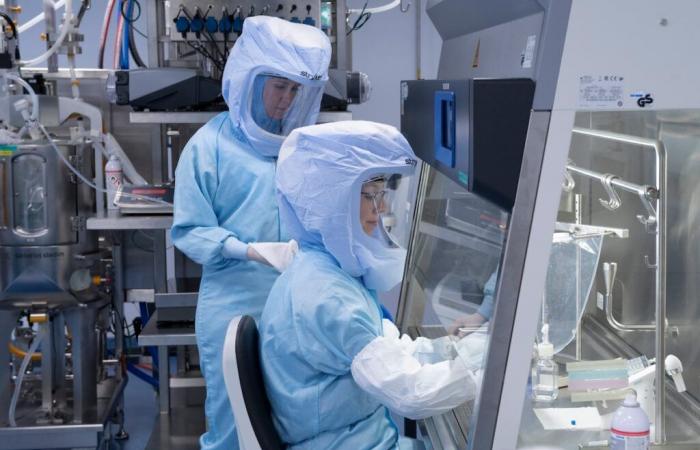
What normally takes 10 years, was done in 10 months. The urgent need for a vaccine during the Ponvirus pandemic pushed hundreds of scientists around the world to look for a solution in record time. In addition to the millions invested and an unprecedented overall collaboration, another factor was key: Messenger RNA technology (MRRy).
This molecule carries the instructions to create a specific protein or a piece of virus and, once it is introduced into the cell, the cell machinery reads it and begins to produce the desired protein or piece of viruses. With the COVID, the instructions allow to manufacture the protein of the virus spone, which will be located and attacked by the immune system. Given the enormous potential of this technology, Biontech and Modern companies agreed to collaborate with the national Health Service of the United Kingdom (NHS) to develop with this method a cancer vaccine. Thousands of people already participate in clinical trials around the world, and the tests are expected to be accepted in early 2026.
“Instead of directly giving you a part of the virus, this technology gives you a model,” blueprintSpanish draft – in the form of RNA with the instructions of how abnormality looks. It is like a tracker dog at an airport: you give it a sample to know what to look for, ”explains the oncologist Lennard Lee, who directs the project in the NHS and directs the Ellison Technology Institute of Oxford.
Lee protected thousands of cancer patients by demonstrating that they could continue to receive chemotherapy during pandemic. In 2020, the potential of the RNM method was discovered: “It allowed to modify the vaccine quickly to protect against different variants of the virus, such as the alpha, beta or omicron. Most of the vaccine remained the same, you only changed the instruction of how it looks.”
At the end of the pandemic, the immunity developer companies began to think of alternatives to redirect their investment. The focus were put in cancer, which is expected to an increase of 47% in cases during the next two decades, according to the Pan American Health Organization. The same institution registered 10 million deaths from this disease in 2022 worldwide.
The United Kingdom was a good option to settle the project for the rapid clinical trials that it carried out during the pandemic, thanks to its large -scale refrigerators and manufacturing facilities. Thus, it has signed an agreement with BIONTECh to provide 10,000 patients access to personalized cancer treatments until 2030. and with Modern has stirred a 10 -year investment to build an innovation and technology center with the capacity to produce up to 250 million vaccines.
Genetics, AI and RNA
To achieve the new cancer vaccine, advances converge in three areas: vaccine technology, genetic sequencing and artificial intelligence. Thanks to the second, you can analyze each pair of bases – the “steps” that form the characteristic staircase of the Cancer, identify what the abnormalities are and incorporate them into the dose. And artificial intelligence, for example, allows you to quickly analyze which of between 1,000 and 10,000 mutations or abnormalities that each cancer has can be recognized by the immune system.
“The first step is to extract the patient’s tumor and perform a genetic sequencing. Then, that information is introduced into an artificial intelligence computer algorithm, which analyzes what are the cancer mutations that the immune system can recognize. The third step is to manufacture a personalized vaccine for that person and, finally, administer it,” Lee explains. Each dose is created individually for each patient’s body. It is made a biopsy, the fabric is sequences and the pharmaceutical companies are sent to design a dose tailored to their cancer. That preparation is useless for anyone else.
An individualized immunity is allowing to fight any type of cancer: lung, pancreas, melanoma, renal, brain tumors, colorectal or bladder. “Vaccines are designed for people who have been detected cancer in time and have been removed. The problem is usually that, from there, they live with the constant concern of whether cancer will return. What they do now these vaccines is to enter the immune system so that he learns to recognize how that specific cancer cell is relapsed, ”says the oncologist.
Essays in Spain
Being personalized doses, clinical trials may take more than normal. Therefore, Lee launched at the end of 2022 the cancer vaccine launch platform to accelerate the tests. And in January this year, along with several other British oncologists, he disclosed the first strategic report on advances in cancer vaccines, published by the magazine Prism of Cambridge: precise medicine, from the University of Cambridge. Among other points, the document recommends that nations have a modern essay infrastructure and involve the public in this development.
The result of the efforts has been thousands of volunteers who are undergoing clinical tests in the third phase, in hospitals from 25 countries on four continents. Among them, Spain, with six vaccination centers distributed between Barcelona, Madrid, Malaga and Valencia. At the head is the United States, with 34 hospitals, far ahead of the second, Germany (12). “Trust has a lot to do. In 2020, the world was able to develop a vaccine in a single year. That changes the mentality. Now, the question is: why can’t we also accelerate cancer vaccines? They are moving forward at great speed, because people saw that the vaccine in the pandemic worked. It is a very exciting moment for science.”
It remains to wait for the results of the tests and then obtain the approval of agencies such as the FDA or the EMA. Lee projects that the tests will be approved in early 2025 and that, throughout the next year, vaccines are already being used as “a more agile alternative than prolonged chemotherapy.” However, he clarifies that it should not be understood as a substitute for traditional treatments, but as an essential addition to the arsenal of immunotherapy options.
How accessible and popular will the cancer vaccine be? “For now nobody knows with certainty how much they will cost. On the one hand, vaccines are usually cheap to produce. But it is also true that a national infrastructure is needed capable of making genomic sequencing of the tumor, which is an additional cost,” replies the British oncologist. The final price will be determined by pharmaceutical companies once the vaccines are approved.
Tendencies It is a project from El País, with which the newspaper aspires to open a permanent conversation about the great challenges of the future that our society faces. The initiative is sponsored by Abertis, Enagás, EY, Groupm, Iberdrola, Iberia, Mapfre, the Organization of Ibero -American States (OEI), Redeia, and Santander and the Strategic Partner Oliver Wyman.
You can sign up here To receive the weekly newsletter from El País trends, every Tuesday, by the journalist Javier Sampedro.





